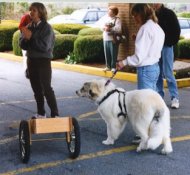

![]() The next part of a demo involved teaching a 7 month old Pyr puppy, Addie, owned by Laura Johnston of WI. Apparently this puppy had been in harness for the first time on the previous day. You can see here that the pup isn't bothered by the harness, or by being the centre of attention for a large crowd of strange people. Beth explained that the dog must be allowed to get accustomed to the harness - show it to the dog, let the dog sniff at it, put the harness on the dog and praise, praise, praise! Wearing the harness must be a fun and happy thing!
The next part of a demo involved teaching a 7 month old Pyr puppy, Addie, owned by Laura Johnston of WI. Apparently this puppy had been in harness for the first time on the previous day. You can see here that the pup isn't bothered by the harness, or by being the centre of attention for a large crowd of strange people. Beth explained that the dog must be allowed to get accustomed to the harness - show it to the dog, let the dog sniff at it, put the harness on the dog and praise, praise, praise! Wearing the harness must be a fun and happy thing!
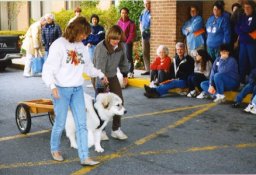
![]() To get the puppy used to shafts, Beth walked alongside of the pup and handler. Beth pulled the cart by the left shaft, and walked with the right shaft beside the puppy. As they moved along the road, Beth would gently bump the puppy with the shaft, getting the pup accustomed to how the real shafts will feel on either side. At this point, as the group stops, the cart is pulled away from the puppy and the pup is praised, praised, PRAISED for the good work. They repeated this process a couple of times.
To get the puppy used to shafts, Beth walked alongside of the pup and handler. Beth pulled the cart by the left shaft, and walked with the right shaft beside the puppy. As they moved along the road, Beth would gently bump the puppy with the shaft, getting the pup accustomed to how the real shafts will feel on either side. At this point, as the group stops, the cart is pulled away from the puppy and the pup is praised, praised, PRAISED for the good work. They repeated this process a couple of times.

![]() Once the pup seems content with the shaft on the outside, the next step to move the pup in a straight line while holding the cart shafts on either side of the puppy. Note: You MUST be sure that the dog is comfortable with the single shaft before moving to this stage. Dogs do NOT like the shafts enclosing them, and it is possible to "spook" a dog and make the dog afraid of the cart by putting the dog in shafts too early.. Pyrs seem very calm and accepting, and don't normally freak out when the shafts are introduced. However, Beth stressed that this part needs two people - one to work the dog, and the other to hold the shafts in place. Should the dog appear too concerned or nervous, and at the end of the straight path, the person with the cart shafts just lifts the shafts up to release the dog. The group turns around, the cart person lowers the shafts on either side of the dog, and off you go. Repeat until the dog seems comfortable moving in a straight line with the shafts held on either side of the bofy.
Once the pup seems content with the shaft on the outside, the next step to move the pup in a straight line while holding the cart shafts on either side of the puppy. Note: You MUST be sure that the dog is comfortable with the single shaft before moving to this stage. Dogs do NOT like the shafts enclosing them, and it is possible to "spook" a dog and make the dog afraid of the cart by putting the dog in shafts too early.. Pyrs seem very calm and accepting, and don't normally freak out when the shafts are introduced. However, Beth stressed that this part needs two people - one to work the dog, and the other to hold the shafts in place. Should the dog appear too concerned or nervous, and at the end of the straight path, the person with the cart shafts just lifts the shafts up to release the dog. The group turns around, the cart person lowers the shafts on either side of the dog, and off you go. Repeat until the dog seems comfortable moving in a straight line with the shafts held on either side of the bofy.
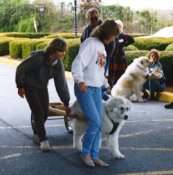
![]() In order to run the demo, Beth next hooked the shafts throught the loops on the harness, and the group walked with the pup feeling a bit of weight on the harness. Note that this pup is only seven months old. During the questions after the demo, Beth indicated that it's possible to get the dogs accustomed to the harness at an early age, and pulling a light weight (such as this cart - about 24 pounds) at seven months is not too taxing on the dog's limbs and joints. Other groups recommend waiting until 18 months or older before putting any weight on the dog.
In order to run the demo, Beth next hooked the shafts throught the loops on the harness, and the group walked with the pup feeling a bit of weight on the harness. Note that this pup is only seven months old. During the questions after the demo, Beth indicated that it's possible to get the dogs accustomed to the harness at an early age, and pulling a light weight (such as this cart - about 24 pounds) at seven months is not too taxing on the dog's limbs and joints. Other groups recommend waiting until 18 months or older before putting any weight on the dog.

![]() Beth also indicated that she was rushing things somewhat, although this puppy in particular seemed quite happy with the change. The traces are NOT connected, and the helper (Beth) is walking alongside to pull the shafts free and lift them up in case the dog "spooks". In that case, the shafts can be pulled back and lifted up quickly to free the dog. Pushing to get to this part too soon can kill interest in your dog, and slow the training schedule.
Beth also indicated that she was rushing things somewhat, although this puppy in particular seemed quite happy with the change. The traces are NOT connected, and the helper (Beth) is walking alongside to pull the shafts free and lift them up in case the dog "spooks". In that case, the shafts can be pulled back and lifted up quickly to free the dog. Pushing to get to this part too soon can kill interest in your dog, and slow the training schedule.
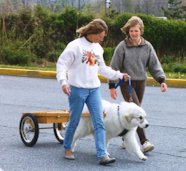
![]() Here we are a couple of minutes later...The traces are connected, and the pup has taken its first short jaunt in shafts. A new carting Pyr is born! Notice that Beth, in the role of helper, is moving alongside the team in case the dog suddenly spooks. In that case, Beth would quickly unhook the traces and pull the shafts out and up, freeing the dog. Things can be going very well, but the dog may lose it the first time you try to turn with the shafts on. In the first few turns, make sure the turn is done very wide and gradual. This stops the shafts from digging into the dog's should or side, and reduces the chances of the dog spooking.
Here we are a couple of minutes later...The traces are connected, and the pup has taken its first short jaunt in shafts. A new carting Pyr is born! Notice that Beth, in the role of helper, is moving alongside the team in case the dog suddenly spooks. In that case, Beth would quickly unhook the traces and pull the shafts out and up, freeing the dog. Things can be going very well, but the dog may lose it the first time you try to turn with the shafts on. In the first few turns, make sure the turn is done very wide and gradual. This stops the shafts from digging into the dog's should or side, and reduces the chances of the dog spooking.
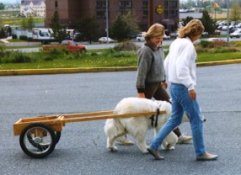
![]() Beth suggests that turns be practiced in a parking lot. Start with very wide turns, and gradually spiral in to the centre. Eventually, the dog will start to cross its feet over each other to reduce the stride required, and allow the cart to pivot around. It's been my personal experience that Pyrs are generally pretty quick at figuring out that the shortest way around the turn is to cross the feet over, and they start to do it naturally.
Beth suggests that turns be practiced in a parking lot. Start with very wide turns, and gradually spiral in to the centre. Eventually, the dog will start to cross its feet over each other to reduce the stride required, and allow the cart to pivot around. It's been my personal experience that Pyrs are generally pretty quick at figuring out that the shortest way around the turn is to cross the feet over, and they start to do it naturally.

![]() Here's Kathy Grimm and her unidentified puppy, pictured with a wagon with a set of the Dog Works shafts attached. Notice that the shafts have a bend in them which allows the shaft to run along the side of the dog, with the shaft parallel to the ground. This particular hookup is interesting, because the shafts can be swung to the outside, and a third shaft added to the middle, allowing a hookup where two dogs can pull the same wagon. Good for heavy loads, or for getting something not so heavy up a hill. Since there is no real balance problem with a wagon, there is very little weight resting on the dog. The shafts are more for steering in this case.
Here's Kathy Grimm and her unidentified puppy, pictured with a wagon with a set of the Dog Works shafts attached. Notice that the shafts have a bend in them which allows the shaft to run along the side of the dog, with the shaft parallel to the ground. This particular hookup is interesting, because the shafts can be swung to the outside, and a third shaft added to the middle, allowing a hookup where two dogs can pull the same wagon. Good for heavy loads, or for getting something not so heavy up a hill. Since there is no real balance problem with a wagon, there is very little weight resting on the dog. The shafts are more for steering in this case.
| Carting Demo (Pt. 1) | Carting Demo (Pt. 2) | Go to Carting with Your Dog Page |
Copyright © 2000 Warrick Wilson
Portions copyright by original authors and photographers.
This page and content may not be reproduced without permission from Warrick Wilson.